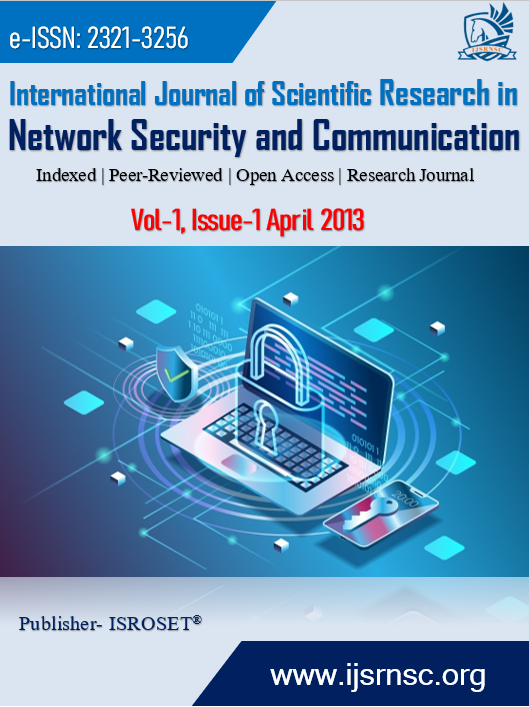Client Adaptive Load Balancing in DSR
Keywords:
MANETs, Routing Protocols, DSR, O-DSR, M-DSRAbstract
A mobile ad hoc network is a collection of wireless mobile hosts forming a temporary network without the aid of any centralized administration or standard support services regularly available in wide-area networks to which the hosts may normally be connected In this paper, we present an effective scheme to balance the load in ad hoc network. The scheme can be applied in most on-demand routing protocols. It is implemented in the process of route request. When route request (RREQ) messages are flooded to acquire routes, Only the qualified nodes, which have a potential to serve as intermediate forwarding nodes, will respond to these messages, so that the established path will not be very congested, and the traffic will be distributed evenly in the network. In this scheme, a threshold value, which is used to judge if the intermediate node is overloaded, is variable and changing along with the nodes’ interface queue occupancy around the backward path. Therefore, we call it an adaptive load-balancing approach and the performance of routing overhead and average end-to-end delay is also improved.
References
Umesh Kumar Singh, Shivlal Mewada, Lokesh Laddhani & Kamal Bunkar,“an Overview & Study of Security Issues in Mobile Adhoc Networks”,Int. Journal of Computer Science and Information Security (IJCSIS) USA, Volume-9, No.4, pp (106-111), April 2011.
Lee, S. J. and Gerla, M., “AODV-BR: Backup Routing in Ad hoc Networks,” Proc. of IEEE Wireless Communications and Networking Conference, pp. 1311-1316 (2000).
Li, X. F. and Cuthbert, L., “On-demand Node-disjoint Multipath Routingin Wireless Ad hoc Networks,” Proc. of the 29th Annual IEEE International Conference on Local Computer Networks (LCN’2004).
Shivlal Mewada and Umesh Kumar Singh, “Measurement Based Performance of Reactive and Proactive Routing Protocols in WMN”, Int. Journal of advanced research in Computer Science and Software Engineering, Vol. 1, No. 1, pp(1-4), Dec.-2011.
Jiang, M. H. and Jan, R. H., “An Efficient Multiple Paths Routing Protocol for Ad-hoc Networks,” Proc. of the 15th International Conference on Information Networking, pp. 544-549 (2001).
Macker J M, Corson, Park V. Mobile and wireless internet services: Putting the Pieces together. IEEE Communications Magazine, 2001, 36: 146-155.
Clausen T, Jacquet P. Optimized link state routing protocol.IETF RFC 3626, network Working Group, October 2003.
Parkens C E, Bhagwat P. Highly dynamic Desination-Sequenced Distance-Vector Routing (DSDV) for mobile computers. Computer Communications Review, 1994, 24 (4): 234-244.
Perkins C, Belding-Royer E, Das S. Ad hoc on-demand Distance Vector Routing. July 2003, RFC 3561.
Johnson D B, Maltz D A, Broch J. DSR- The dynamic source routing protocol for multi hop wireless ad hoc networks. In Ad hoc Network, Chapter 5, (Perkins C E eds.), Addison-Wesley, 2001.
Corson S, Park V. Temporally-Ordered Routing Algorithm (TORA) Version 1 Functional Specification. Mobile Ad Hoc Network (MANET) Working Group, IETF, Oct. 1999.
[12] Toh C K. A novel distributed routing protocol to support adhoc mobile computing. In Proc. 15th IEEE Annual Int. Phoenix Conference on Computers and Communication. 1996, pp. 480-486.
Lei Wang, Lianfang Zhang,Yantai Shu, Miao Dong. Multipath source routing in wireless ad hoc networks. 2000 Canadian Conference on Electrical and Computer Engineering, 2000, 1, pp. 479-483.
Downloads
Published
How to Cite
Issue
Section
License

This work is licensed under a Creative Commons Attribution 4.0 International License.
Authors contributing to this journal agree to publish their articles under the Creative Commons Attribution 4.0 International License, allowing third parties to share their work (copy, distribute, transmit) and to adapt it, under the condition that the authors are given credit and that in the event of reuse or distribution, the terms of this license are made clear.









